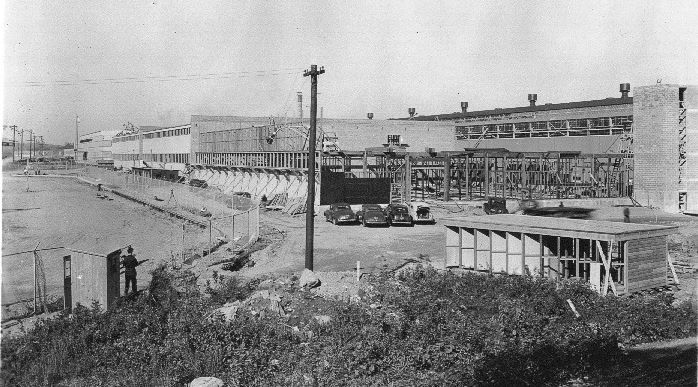Hingham Municipal Lighting Plant, MA 1942-1944, K-Frame Transmission Line, WW2
By Joe Maurath, Jr.; posted July 31, 2020
View Original: Click to zoom, then click to magnify (698 x 387) 92KB

|
Along the left is the same (other end) of the New England Power "K-frame" 13.2kv transmission line that provided power to this enormous WW2 government shipbuilding facility (also see "Previous"). The cameraman of that picture took that shot somewhere near the far left upper corner of this image (about a half mile away). These lines were pretty huge and so was the Bethlehem Steel Shipyard complex that they served. Their source was from neighboring Weymouth, MA. The municipal utility in Hingham did not have capacity of serve such a large operation, so the New England Power Company was the provider. This line stood for decades and the insulators from it were made by Locke having early 1940s dates on them. Most of the old buildings are now gone. In their place are stores, shops, a park, condominiums and boat launching areas. If you would like a current view, look along Lincoln Street heading west just beyond the intersection of Fottler Road. At the end of 1942 the Hingham Light Board reported: " The plant has been maintained in first class condition during the past year, but increases in services and extensions of lines have practically ceased on account of Government requirements. Partly for this reason and partly because a considerable part of the year's payroll expense has been paid for by the U.S. Government for work required for the Army and Navy and Shipbuilding plant, we have been able to return $15,000 to the Town Treasury from earnings. "The line work done for the Government was done at regular rates as we did not believe that the people of Hingham would want to profiteer on war work, and the result was a considerable saving to the Government." News in 1943: "For the second year there has been practically no new extensions of plant and a large part of our line work has been done for the Government, which has paid part of our payroll expense." The town saved $3,028.67 during the year... "in street lighting, the latter item reflecting current saved during the dimout." Many street lamps throughout were either shut off or had lower-output bulbs installed in them. In addition, special blackout light bulbs designed for street lighting service also were installed (a photo of one will be posted here in the near future). These efforts were to significantly reduce the chance of an enemy bomber seeing any occupied land areas at night. News from 1944: Government restrictions continued to prohibit new lines, poles, extensions and additions (except for government locations). "Funds from earnings which would normally have been spent on improvements leave us in a position to go ahead at once as soon as the war is over. In the meantime the plant has been kept up to the highest point that lack of supplies permits." The street lighting dimout continued throughout 1944 and $1,659.71 was saved from its budget, returned to the town treasury at the end of the year. The pole in the foreground was owned by the Hingham Light Plant. It supported a shaded street light (it was more like a flood light) and ran from the series street lighting system that ran along the roadway along the left. It illuminated the guard shack that you see. The WW2 years were indeed challenging throughout America. Hingham with its own utility was no exception. Above are some news items from 1942-1944. Like a lot of other documentation I have provided about this town's electric system, similar conditions and very comparable experiences can be said for the great many other publicly owned electric utilities of this time frame. |